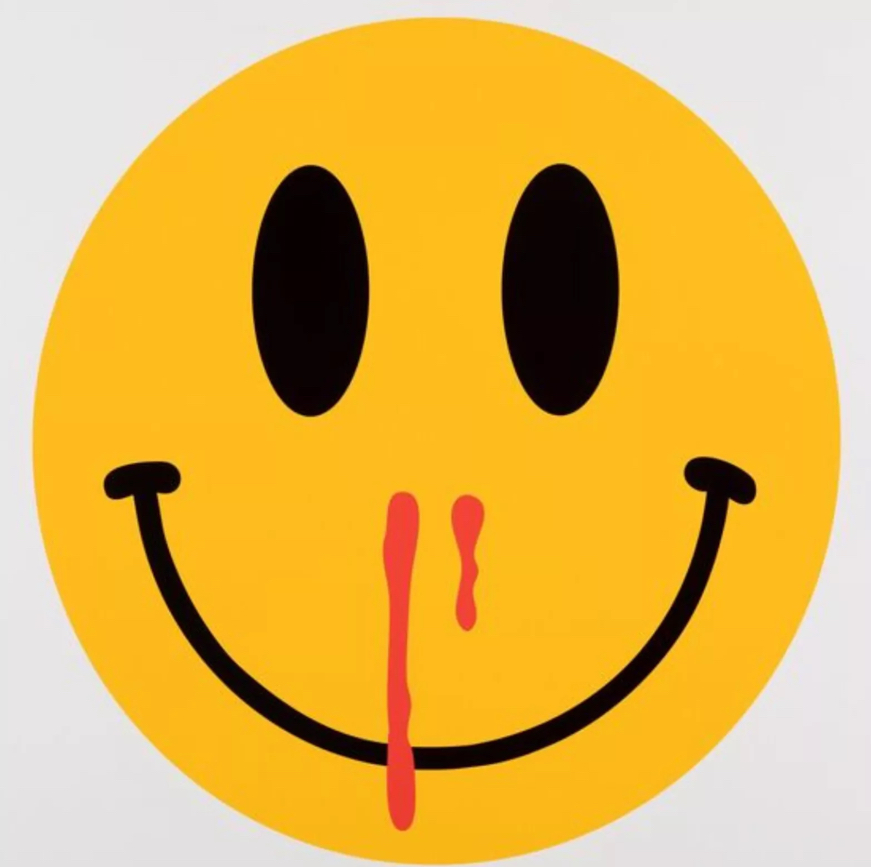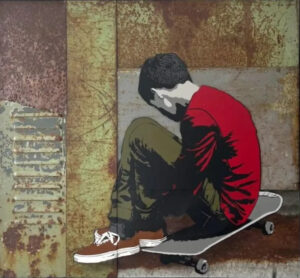
In the saturated realm of post-pop Japanese art, few artists have weaponized visual chaos as effectively as MADSAKI. A rebellious graduate of Parsons and a key member of Takashi Murakami’s Kaikai Kiki collective, MADSAKI has become synonymous with the erratic, emotionally charged visual language of modern-day hybridity. His 2020 screenprint “Happiness Overdose Yellow_P”, measuring 70x50cm and produced in a limited edition of 300, is a direct strike against aesthetic conventions—at once playful, violent, acidic, and meditative. In the years since its release, this work has come to represent not only a distillation of MADSAKI’s artistic ethos but also a haunting reflection of a world locked in digital delirium.
Executed at Dai Nippon Printing, one of Tokyo’s most technically accomplished printing houses, the work is the result of an exhaustive 37-layer screenprinting process. Each layer is a deliberate act of control and entropy. The piece’s use of DayGlo yellow, neon pink, and fluorescent teal ink suggests a deliberately synthetic intensity, but the real breakthrough lies in its intentional misregistration—a method MADSAKI has adapted from his signature spray-can aesthetic, where precision collapses under emotional urgency. Ink overlaps, rogue splatters, and clashing forms simulate a visual field on the brink of digital failure. UV-reactive pigments hidden in the composition emerge only under blacklight, reinforcing its kinetic, rave-era sensibility.
“Happiness Overdose Yellow_P” is a seizure-inducing image with emotional range. Look at it once, and you see a manga hallucination; look again, and it begins to vibrate with the dread of information overload. Its center is dominated by a monstrous face—equal parts Doraemon, The Joker, and the glitchy avatars of early web 2.0. The eyes, adapted from manga archetypes, are red-ringed and bloodshot. The smile is wide, toothy, unnerving—referencing not just Disney’s sanitized iconography, but the smeared chaos of late Heath Ledger-era villainy. Around this face swarm pop-art echoes: Basquiat crowns distorted into cracked anime headbands, Pollock-like drips flowing vertically in algorithmic repetition, and background scribbles that recall both children’s drawings and circuit diagrams.
What MADSAKI achieves here is a synthesis of three cultural legacies: American postmodernism, Japanese subculture, and the global language of screen-based reality. His work has long engaged in ironic appropriation—repainting old master works like The Last Supper or Mona Lisa in his trademark scribbled style—but “Happiness Overdose Yellow_P” is less about parody and more about invocation. This is a psychic totem for a generation raised on anime, fed by social media, and exhausted by the weight of too much content.
Critically, the work was lauded immediately upon release. Cathy Bao of Artforum described it as, “Like Takashi met Jean-Michel in Akihabara then set the drawing on fire.” Others called it MADSAKI’s most “aesthetically mature” work to date, a turning point from playful irreverence toward total psychic exposure. The original retail price in 2020 was set at ¥380,000, or roughly $3,500 USD, but resale values skyrocketed after a single image of K-pop icon G-Dragon purchasing the work was posted on Instagram. By 2023, a copy had sold for $18,750 at Phillips Hong Kong, and current offers reportedly exceed $22,000 on the private secondary market.
The piece’s rise in value is partly attributable to its limited edition and high production quality, but more so to the emotional resonance it found during the global pandemic. Created during Japan’s first COVID lockdown, “Happiness Overdose Yellow_P” embodies what MADSAKI himself described in interviews as “digital delirium.” It was a time when video calls replaced intimacy, when screen brightness became a form of companionship, and when laughter—once organic—became an emoji reaction. The color palette, especially the searing yellow, functions less as joy and more as warning. Kenji Kajiya, writing for Bijutsu Techo, noted: “That yellow isn’t happiness—it’s the warning color of radioactive decay.” It signals both caution and contagion, as if joy itself has become too dangerous to contain.
What makes the piece especially relevant in today’s art landscape is its rejection of the AI-perfect aesthetic. In a visual culture where smoothness, symmetry, and hyper-polished renders dominate—where artists use Midjourney to produce algorithmic perfection—MADSAKI’s screenprint revels in failure. You can see the ink pooling, the layering gone awry, the edges where one hue bled into another. These are not flaws—they are authenticity markers. The print becomes a human glitch, proof that it was made by a person, not a program.
This analog immediacy was further reinforced through the work’s exhibition history. It first appeared in the 2020 exhibition Superflat Pandemic at the Kaikai Kiki Gallery in Tokyo—a show curated by Murakami himself to explore the psychological toll of quarantine through a postmodern lens. From there, it traveled to Post-Pop Dreams at Perrotin Shanghai, where it was installed under blacklight, allowing the UV-reactive elements to emerge in full spectral violence. In 2022, the work was featured in Anime Architecture at M+ Museum Hong Kong, shown alongside animation storyboards and digital media relics from Studio Ghibli to Gainax. The following year, a MADSAKI retrospective at Nanzuka Underground in Tokyo placed the screenprint at the entrance, flanked by two graffiti-tagged vending machines—a wink to the absurd consumerism the piece critiques.
Institutionally, the print is already enshrined in significant collections. The Mori Art Museum in Tokyo holds one in its permanent holdings, as does M+ Museum in Hong Kong. Kaikai Kiki Gallery maintains a rotating copy for display, often loaned for satellite exhibitions across Asia and Europe. While no Western museum has publicly acquired a copy yet, interest from private collectors—particularly in Los Angeles and Seoul—is reportedly high.
What also elevates this work beyond MADSAKI’s earlier pieces is its intertextual density. You don’t just view it—you decode it. Each motif acts as a visual hyperlink to some half-remembered cartoon, art history reference, or piece of digital detritus. The Basquiat crown, in particular, appears fractured—its symmetry broken and fused to an anime character’s forehead. The viewer is forced to ask: is this reverence or mockery? Is MADSAKI honoring Jean-Michel’s radical inheritance or sabotaging its canonization? The answer, as with much of MADSAKI’s work, is both.
There’s also a spiritual violence to the piece. Spray paint—his medium of choice—is chaotic, airborne, semi-permanent. Translating that immediacy into screenprint form is not just a technical challenge but a conceptual one. It’s an attempt to freeze emotion mid-spasm. It also riffs on MADSAKI’s own biography: born in Osaka, raised in New Jersey, MADSAKI has often spoken about feeling “culturally in-between.” This liminality plays out visually here, where American street art, Japanese media culture, and European art theory all swirl together in a single technicolor breakdown.
In the current art economy—flooded with AI art, metaverse galleries, and limited-run NFT spectacles—Happiness Overdose Yellow_P is a refreshingly analog protest. It sweats. It glitches. It pulses under blacklight like a nuclear warning. It reminds us that madness, laughter, and cultural memory are not neat packages to be sorted by algorithm, but volatile chemicals that—when combined—either explode or heal.
As of this writing, the print remains sold out through Kaikai Kiki. Copies on the secondary market range from $19,000–$23,000, with condition and signature placement affecting pricing. Those looking to acquire one are advised to monitor auction houses like Phillips, Sotheby’s, and Artcurial, where MADSAKI’s works continue to climb. For now, “Happiness Overdose Yellow_P” stands as both a time capsule and a forecast—capturing the chaos of a generation raised on digital noise, and hinting at the future of image-making in a post-authenticity age.
This isn’t just a screenprint. It’s an anxiety diary, a meme in meltdown, a sublime scream from the edge of overload. In MADSAKI’s hands, joy isn’t sanitized. It’s poisoned, pixelated, and sprayed directly onto your retina. And it’s beautiful.
No comments yet.








